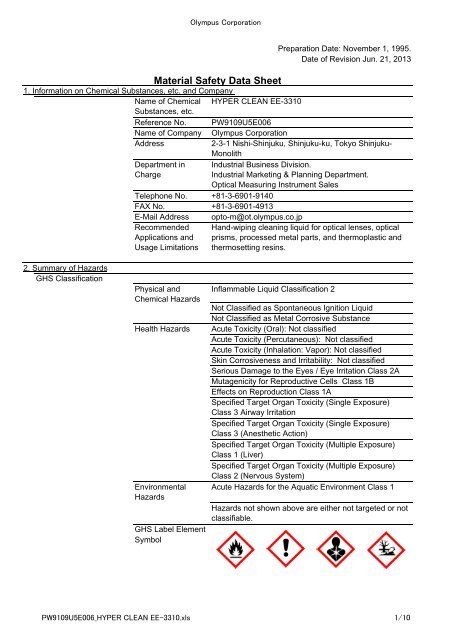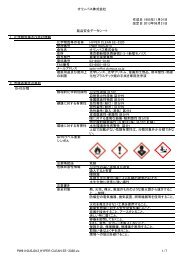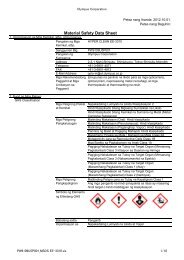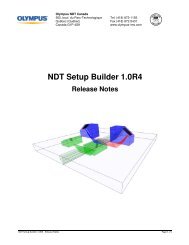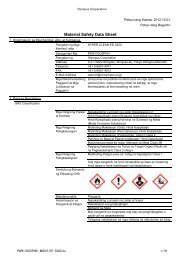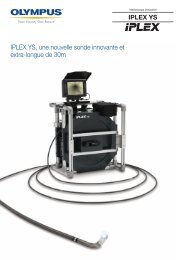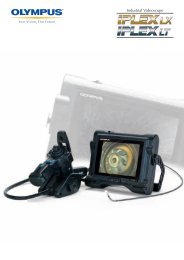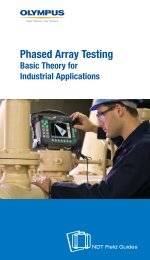PW9109U5E006_HYPER CLEAN EE-3310 - Olympus
PW9109U5E006_HYPER CLEAN EE-3310 - Olympus
PW9109U5E006_HYPER CLEAN EE-3310 - Olympus
- No tags were found...
Create successful ePaper yourself
Turn your PDF publications into a flip-book with our unique Google optimized e-Paper software.
<strong>Olympus</strong> CorporationMaterial Safety Data SheetPreparation Date: November 1, 1995.Date of Revision Jun. 21, 20131. Information on Chemical Substances, etc. and CompanyName of Chemical <strong>HYPER</strong> <strong>CLEAN</strong> <strong>EE</strong>-<strong>3310</strong>Substances, etc.Reference No. <strong>PW9109U5E006</strong>Name of Company <strong>Olympus</strong> CorporationAddress2-3-1 Nishi-Shinjuku, Shinjuku-ku, Tokyo Shinjuku-MonolithDepartment inChargeTelephone No.FAX No.E-Mail AddressRecommendedApplications andUsage LimitationsIndustrial Business Division.Industrial Marketing & Planning Department.Optical Measuring Instrument Sales+81-3-6901-9140+81-3-6901-4913opto-m@ot.olympus.co.jpHand-wiping cleaning liquid for optical lenses, opticalprisms, processed metal parts, and thermoplastic andthermosetting resins.2. Summary of HazardsGHS ClassificationPhysical andChemical HazardsHealth HazardsEnvironmentalHazardsGHS Label ElementSymbolInflammable Liquid Classification 2Not Classified as Spontaneous Ignition LiquidNot Classified as Metal Corrosive SubstanceAcute Toxicity (Oral): Not classifiedAcute Toxicity (Percutaneous): Not classifiedAcute Toxicity (Inhalation: Vapor): Not classifiedSkin Corrosiveness and Irritability: Not classifiedSerious Damage to the Eyes / Eye Irritation Class 2AMutagenicity for Reproductive Cells Class 1BEffects on Reproduction Class 1ASpecified Target Organ Toxicity (Single Exposure)Class 3 Airway IrritationSpecified Target Organ Toxicity (Single Exposure)Class 3 (Anesthetic Action)Specified Target Organ Toxicity (Multiple Exposure)Class 1 (Liver)Specified Target Organ Toxicity (Multiple Exposure)Class 2 (Nervous System)Acute Hazards for the Aquatic Environment Class 1Hazards not shown above are either not targeted or notclassifiable.<strong>PW9109U5E006</strong>_<strong>HYPER</strong> <strong>CLEAN</strong> <strong>EE</strong>-<strong>3310</strong>.xls 1/10
<strong>Olympus</strong> CorporationAlert wordDanger and HazardInformationPrecautionsSafety MeasuresEmergency MedicalMeasuresDangerHighly Inflammable Liquid and VaporStrong Eye IrritantDanger of Genetic DiseaseDanger of Harm to Reproductive Function and FetusesDanger of Respiratory IrritationDanger of Drowsiness and DizzinessLiver Damage with Long-term or Repeated ExposureDanger of Damage to Nervous System with Long Termor Repeated ExposureVery toxic to aquatic lifeAlways obtain the Instruction Manual before use.Read all safety precautions and fully understand thembefore handling the product.Keep away from ignition sources such as heat, sparks,or open flame. Do not smoke when using the product.Use explosion-proof electrical equipment, ventilators,lighting, etc.Use tools that do not generate sparks.Take safety measures to discharge static electricity.Ground the container. Use a grounding wire.Keep in a cool place.Keep the container tightly sealed.Use the product outdoors or in a well-ventilated area.Do not inhale the mist, vapor, or spray.Wear protective gloves, protective eyeglasses and aprotective mask.Use designated individual protective equipment.Wash your hands thoroughly after handling the product.Do not eat, drink, or smoke when using the product.Avoid discharging the product into the environment.In case of fire, use the proper fire extinguisher.If the spray is inhaled, remove the victim to fresh air andkeep them in a rest position comfortable for breathing.If the product adheres to the skin or hair, immediatelyremove any contaminated clothes and wash the skin orhair with running water or a shower.If the product comes on contact with the eyes, washthoroughly for several minutes. When contact lenses areused and are easily removable, remove them, andcontinue washing the eyes.If irritation of the eyes persists, see a physician fordiagnosis and treatment.<strong>PW9109U5E006</strong>_<strong>HYPER</strong> <strong>CLEAN</strong> <strong>EE</strong>-<strong>3310</strong>.xls 2/10
<strong>Olympus</strong> CorporationStorageIn case of exposure or fear of exposure, see a physicianfor diagnosis and treatment.If you feel unwell after using the product, see aphysician for diagnosis and treatment.Store in a cool, well-ventilated area.Store the product in a locked area.DisposalImportant Dangersand Hazards3. Information on Composition and ComponentsClassification of Substance or MixtureChemical Name or General NameKeep the container tightly sealed and store it in a wellventilated area.Contents, if you discard the containers, according tolocal regulations, and proper disposal.The product is an easily ignitable liquid and forms anexplosive mixture with air.MixtureSilicone Cleaning LiquidChemical Name orGeneral NameConcentration orRange ofConcentrationCAS No.Methyl Siloxane 60-70% 107-46-0Ethanol 40-30% 64-17-5Impurities and StabilizerAdditives that Contribute tothe ClassificationNo Information4. Emergency MeasuresIf the product is inhaledIf the product adheres tothe skinIf the product comes incontact with the eyesIf the product is swallowedRemove the victim to fresh air and keep them in a restposition comfortable for breathing.Receive a diagnosis and treatment from a physician.Wash the skin immediately.Receive a diagnosis and treatment from a physician.Wash thoroughly with water for a few minutes. If contactlenses are worn and are easy to remove, remove them,and continue to wash the eyes.Receive a diagnosis and treatment from a physician.Rinse the mouth.Receive a diagnosis and treatment from a physician.<strong>PW9109U5E006</strong>_<strong>HYPER</strong> <strong>CLEAN</strong> <strong>EE</strong>-<strong>3310</strong>.xls 3/10
<strong>Olympus</strong> CorporationExpected acute symptomsand delayed symptomsProtection of the personconducting first-aid5. Measures to be taken in case of fireFire Extinguishing AgentsFire extinguishers thatshould not be usedSpecific Dangers andHazardsSpecial fire extinguishingmethodProtection for person(s)conducting the firefighting6. Measures taken for leakagePrecautions for the body,protective equipment, andemergency measuresIf the product adheres to the skin, it has a weaksurfactant action, and may cause dry skin.Because the product is highly flammable, be careful offlame when treating at the site.For a small fire, use dry powder chemicals, carbondioxide, water spray or general foam extinguishers.For a large fire, use water spray, water mists or generalfoam fire extinguishers.Flooding with waterExtremely flammable. Easily ignited by heat, sparks, orflame.There is danger of explosion if the container is heated.There is a danger of generating gases that are irritating,corrosive and/or toxic.There is danger of vapor explosion indoors, outdoors, orin waste water ditches.The ignition point is extremely low. For a large firewhere fire extinguishing means other than sprayingwater are not effective, use water spraying.If not dangerous, move the containers away from the firearea.Conduct firefighting activities from the farthest effectivedistance, and use automated hose holders or nozzleswith monitors for firefighting.For a large fire, conduct fire fighting with automatedhose holders and nozzles with monitors. If this isimpossible, seek refuge in a safe place, and allow thecontainers to burn.Use plenty of water to thoroughly cool the containers,even after the fire is extinguished.When fighting a fire, wear an respirator and protectiveclothes against chemicals.Do not touch or walk in any spillage.Immediately isolate the spillage area a suitable distancein all directions.Limit access to only authorized personnel.Workers shall wear suitable protective equipment (Referto 8. Exposure Prevention Measures and ProtectiveRemain upwind of the site.Keep away from low ground.Ventilate a closed space before entering it.<strong>PW9109U5E006</strong>_<strong>HYPER</strong> <strong>CLEAN</strong> <strong>EE</strong>-<strong>3310</strong>.xls 4/10
<strong>Olympus</strong> CorporationPrecautions related to theenvironmentRecovery andNeutralizationContainerization andClarification Methods andEquipmentMeasures to PreventSecondary Disasters7. Precautions for Handling and StorageHandlingTechnicalCountermeasuresLocal Exhaust andGeneral VentilationPrecautionary ItemsRelated to SafetyHandlingAvoid contactDo not discharge the spillage into the environment.Be careful not to discharge the spillage into rivers, whichwill cause environmental problems.For a small amount, absorb the spillage with dry soil,sand, or another incombustible material or cover thespillage, and recover it in tightly sealable containers.Dispose of the recovered material later.If the spillage is small, collect the absorbent materialusing clean, anti-static tools.If the spillage is large, surround the area with a bank toprevent out-flow. After directing the spillage to a safearea, conduct the recovery.If the spillage is large, water spray will lower the vaporconcentration. However, in a tightly enclosed area thereis a risk of not effectively suppressing the flammability ofthe product.If the situation does not present any danger, stop theleakage.Ground all equipment used for handling the spillage.Use vapor suppressing foam to lower the vaporconcentration.Remove all ignition sources promptly. (Prohibit smokingand use of sparks and flame in the vicinity.)Prevent flow into waste water ditches, sewage ditches,basements and enclosed areas.Conduct the facility measures described in 8. ExposurePrevention Measures and Protective Measures andwear protective equipment.Use local exhaust and general ventilation measuresdescribed in 8. Exposure Prevention Measures andProtective Measures.Obtain the Instruction Manual prior to use.Read all safety precautions and fully understand thembefore handling the product.Prohibit use of high temperature material, sparks andflame near the product.Containers should not be tumbled, dropped, bumped ordragged.Do not touch, inhale or swallow the product.Use exhaust ventilation to keep the concentration in theair below the exposure limit.Wash your hands thoroughly after handling the product.Use the product outdoors or in a well-ventilated area.Do not eat, drink, or smoke when using the product.Refer to 10. Stability and Reactivity.<strong>PW9109U5E006</strong>_<strong>HYPER</strong> <strong>CLEAN</strong> <strong>EE</strong>-<strong>3310</strong>.xls 5/10
<strong>Olympus</strong> CorporationStorageTechnicalCountermeasuresHazardoussubstance whenmixedStorage ConditionsContainer packagingmaterialsMake sure the storage area for the product has a fireresistant structure for the walls, pillars, and floors.Beams shall be made of incombustible material.The roof of the storage area for the product shall bemade of incombustible material and covered with lightweightincombustibles, such as metal sheet. Thereshould be no ceiling.The floor of the storage area for the product shall have astructure that will not allow water to enter or penetratethe floor surface.The floor of the storage area for the product shall have astructure that will not allow dangerous substances topenetrate, and shall have a suitable slope and gutter forretaining spillage.The storage area for the product shall be equipped withsuitable lighting, illumination, and ventilation for storingand handling dangerous substances.Refer to 10. Stability and Reactivity.Store by keeping away from ignition sources such asheat, sparks, and open flame. No smoking is allowednear the product.Store the container away from oxidants.Keep the containers away from sunlight and flame.Keep the containers tightly sealed, and store in a cool,well-ventilated area.Store the product in a locked area.Use containers that are defined in the UN transportregulations.8. Exposure Prevention Measures and Protective MeasuresControlConcentrationPermissible concentration (Exposure Limit ValueBiological Exposure Index)Japan Society forACGIHOccupational Health2009 Edition2009 EditionMethyl SiloxaneUndetermined UndeterminedUndeterminedEthanolUndetermined UndeterminedTWA 1000 ppmFacility CountermeasuresUse explosion-proof electrical, ventilating andilluminating equipment.Take steps to prevent static electricity discharge.Install eye washing equipment and safety showers in thework area where the product is stored or handled.For high-heat handling, install ventilating equipment tokeep the air contaminant level below the controlconcentration and the permissible concentration in casevapor, fumes and mist form in the handling process.<strong>PW9109U5E006</strong>_<strong>HYPER</strong> <strong>CLEAN</strong> <strong>EE</strong>-<strong>3310</strong>.xls 6/10
<strong>Olympus</strong> CorporationProtective EquipmentSanitary MeasuresProtective breathingapparatusHand protectionEye ProtectionSkin and bodyprotectionUse individual protective breathing apparatuses, asrequired.Wear protective gloves.Wear protective equipment for the eyes.Protective eyeglasses (ordinary eyeglasses, ordinaryeyeglasses with side plates, goggle-type eyeglasses).Wear protective equipment for the face.Use individual protective clothes and protective masks,as required.Wash your hands thoroughly after handling the product.9. Physical and Chemical PropertiesPhysical Conditions FormColorOdorpHMelting Point and FreezingPointBoiling Point, Initial BoilingPoint, and Boiling RangeFlash PointFlammability or Explosion Lower LimitRangeUpper LimitVapor PressureVapor Density (Air = 1)Specific Gravity (Density)SolubilityOctanol (WaterDistribution Coefficient)Spontaneous IgnitionTemperatureDecompositionTemperatureEvaporation Speed (ButylAcetate = 1)Combustibility (Solid andGas)ViscosityCoefficient of KinematicViscosityLower Limit Concentrationfor Dust ExplosionMinimum Ignition EnergyVolume Resistivity(Conductance)OthersLiquidColorless and transparentAlcohol OdorNo Data -86 deg C (Melting Point)72 deg C (Boiling Point)0 deg C1.8 vol%24.5 vol%9.1kPa (20 deg C)2.90.77 (25 deg C)Insoluble in waterNo Data350 deg CNo DataNo DataNot applicable0.54 mPa / s (25 deg C)0.70No DataNo DataNo DataNo Data<strong>PW9109U5E006</strong>_<strong>HYPER</strong> <strong>CLEAN</strong> <strong>EE</strong>-<strong>3310</strong>.xls 7/10
<strong>Olympus</strong> Corporation10. Stability and ReactivityStabilityPossibility of Hazardousand Harmful ReactionsConditions to avoidHazardous substancewhen mixedHazardous and harmfuldecomposition materials11. Toxicity InformationAcute ToxicitySkin Corrosiveness /IrritationSerious damage andirritation to the eyesSensitization ofRespiratory OrgansSensitization of SkinMutagenicity forReproductive CellsCarcinogenicityReproductive ToxicitySpecific Target OrganToxicity (Single Exposure)OralPercutaneousInhalation (Vapor)Inhalation (Mist)Stable under normal conditionsDangerous and/or toxic reactions do not occur undernormal conditions.Ignition sources, such as heat, sparks, and open flame.OxidantsGases generated by combustion, such as carbonmonoxide, carbon dioxide, etc.As a result of product testing, Not classified wasselected because LD50 10000 mg / kg.Because the estimated value for acute toxicity for thecomponent Methyl Siloxane is 12200 mg / kg and theestimated value for acute toxicity for the mixture is12200 mg / kg, Not classified was selected. (35% of thecomponents cannot be classified.)Because the estimated values for acute toxicity for thecomponents are 15956 ppm for Methyl Siloxane and52320 ppm for Ethanol, and the estimated value foracute toxicity for the mixture is 21085.2 ppm for Ethanol,so Not classified was selected.Cannot be classified due to lack of data.Because all components were not classified, Notclassified was selected.As a result of product testing, among the victimssuffering from eye turbidity from vapor it was describedthat almost all recovered within 14 days. Therefore, itwas categorized as Class 2A.Cannot be classified due to lack of data.Cannot be classified due to lack of data.Because Ethanol is Class 1B and is greater than theConcentration Limit (0.1%), it was categorized as Class1B.Cannot be classified due to lack of data.Because Ethanol is Class 1A and is greater than theConcentration Limit (0.3%), the reproductive toxicity wascategorized as Class 1A.Because the Class 3 Component is Ethanol, and thetotal Component Concentration exceeded theConcentration Limits (20%), it was categorized as Class3 (Airway Irritation). Expert opinions for judging Class 3(Airway Irritation) were not sought.Because the Class 3 (Anesthetic Action) Component isEthanol, and the total Component Concentrationexceeds the Concentration Limit (20%) it wascategorized as Class 3 (Anesthetic Action). Expertopinions for judging Class 3 (Anesthetic Action) werenot sought.<strong>PW9109U5E006</strong>_<strong>HYPER</strong> <strong>CLEAN</strong> <strong>EE</strong>-<strong>3310</strong>.xls 8/10
<strong>Olympus</strong> CorporationSpecific Target OrganToxicity (RepeatedExposure)Toxicity to RespiratoryOrgans12. Information on Environmental EffectsAcute toxicity to the Methyl Siloxaneaquatic environmentClass 1 component having a Component Concentrationthat exceeds the Concentration Limit (10%) is Ethanol(Liver). so it was categorized as Class 1 (Liver).Class 2 component having a Component Concentrationthat exceeds the Concentration Limit (10%) is Ethanol(Nervous System). so it was categorized as Class 2Cannot be classified due to lack of data.LC50 Japanese medaka : 1.27mg/L 48hr13. Precautions at the time of disposalResidual WastePrior to disposal, perform as much detoxification, safetyand neutralization treatment as possible, and lower thelevel of hazard and toxicity.The waste is to follow local regulations.Contaminated containersand packagingHow to recycle containers and clean, follow localregulations, and proper disposal.When disposing of empty containers, make certain thatthey are completely empty.14. Precautions in Transportation.International Rules Information onMarine ControlsUN No.Proper ShippingNameClassPacking GroupMarine PollutantInformation onaircraft regulationsUN No.Proper ShippingNameClassPacking GroupFollow the provisions of the IMO.1993FLAMMABLE LIQUID, N.O.S.3IIApplicableFollow the provisions of the ICAO / IATA1993FLAMMABLE LIQUID, N.O.S.3II<strong>PW9109U5E006</strong>_<strong>HYPER</strong> <strong>CLEAN</strong> <strong>EE</strong>-<strong>3310</strong>.xls 9/10
<strong>Olympus</strong> CorporationSpecial Safety Measures15. Applicable Laws and OrdinancesPrior to transportation, verify that the container is notdamaged, corroded, or is leaking.Dangerous goods shall be loaded so that they do notfall, or that the transport containers containing thedangerous goods do not fall, topple, or becomedamaged.Ensure that toppling, bumping, friction, crushing,leakage etc. do not occur during transport.When transporting the product, avoid direct exposure tosunlight, avoid damage, corrosion, and leakage of thecontainers when loading the product and ensure thatmeasures are taken to prevent the load from collapsing.In case of disaster because of an accident duringtransport, report to the nearest firefighting agency andother related agencies.Follow the local regulations.16. Other InformationContact informationReferences<strong>Olympus</strong> CorporationNITE GHS Classification Public Announcement DataEU CLP Regulation Annex VICHEMWATCH Corp. GHS-MSDSRTECS (2006 - 2008)<strong>Olympus</strong> Corporation Product MSDS <strong>HYPER</strong> <strong>CLEAN</strong><strong>EE</strong>-<strong>3310</strong> (Reference No.: <strong>PW9109U5E006</strong>) (2013/06/21Revision)The described contents are based on generallyavailable information and in-house information. Thisdoes not mean that all chemical and technicalinformation at the present time are included. Thus, noguarantees are made. Furthermore, the precautionaryitems provided are only for normal handling. Keep inmind that these precautions may not necessarily beapplicable for special handling.<strong>PW9109U5E006</strong>_<strong>HYPER</strong> <strong>CLEAN</strong> <strong>EE</strong>-<strong>3310</strong>.xls 10/10


